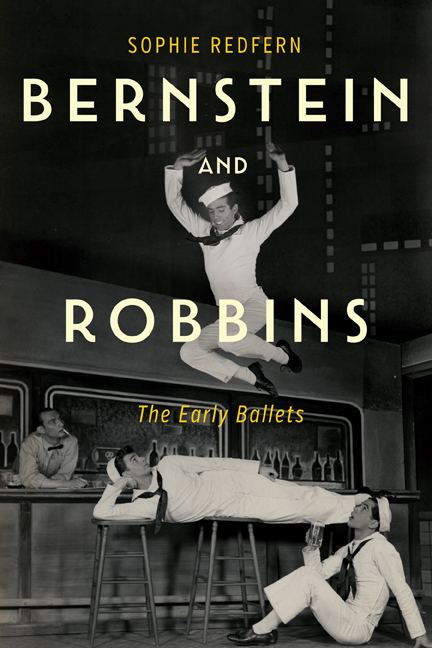Book contents
- Frontmatter
- Dedication
- Contents
- List of Illustrations
- Acknowledgments
- List of Abbreviations
- Editorial Note
- Preface
- 1 Setting the Scene: American Ballet and Jerome Robbins
- 2 Toward a First Ballet: Fancy Free Takes Shape
- 3 Creating Fancy Free: A Long-Distance Collaboration
- 4 The Music of Fancy Free: The Sketches and Score Explored
- 5 The Fancy Free Premiere and a Move to Broadway
- 6 Toward a Second Ballet: Bye Bye Jackie and the Creation of Facsimile
- 7 The Music of Facsimile: The Sketches and Score Explored
- 8 The Facsimile Premiere and Legacy of the Ballets
- Epilogue: Bernstein and Dance
- Bibliography
- Index
1 - Setting the Scene: American Ballet and Jerome Robbins
Published online by Cambridge University Press: 23 March 2021
- Frontmatter
- Dedication
- Contents
- List of Illustrations
- Acknowledgments
- List of Abbreviations
- Editorial Note
- Preface
- 1 Setting the Scene: American Ballet and Jerome Robbins
- 2 Toward a First Ballet: Fancy Free Takes Shape
- 3 Creating Fancy Free: A Long-Distance Collaboration
- 4 The Music of Fancy Free: The Sketches and Score Explored
- 5 The Fancy Free Premiere and a Move to Broadway
- 6 Toward a Second Ballet: Bye Bye Jackie and the Creation of Facsimile
- 7 The Music of Facsimile: The Sketches and Score Explored
- 8 The Facsimile Premiere and Legacy of the Ballets
- Epilogue: Bernstein and Dance
- Bibliography
- Index
Summary
On the evening of April 18, 1944, the audience at the Metropolitan Opera House, New York, exploded into applause at the premiere of the ballet Fancy Free. The response was such that the cast and creative team had to return to the stage for over a dozen curtain calls before finally being allowed to leave. The following morning John Martin, the New York Times dance critic, ran the headline “Ballet by Robbins Called Smash Hit” and stated, “the whole ballet, performance included, is just exactly ten degrees north of terrific.” The principal figure behind this tour de force was Jerome Robbins. It was his idea, he wrote the scenario, secured the collaborators, cast it, choreographed it, and starred as one of the dancers. However, it had taken him years of persistence to get the opportunity to develop a ballet. In May 1940, at twenty-one years of age, he joined the respected company Ballet Theatre but quickly grew tired of the predominantly Russian repertoire that left him performing in “boots, bloomers, a wig and all that stuff” every night. As such he began to harbor choreographic aspirations: “Ballet Theatre … was completely Ballet Russified,” he remembered, “and I thought, ‘why can't we do ballets about our own subjects, meaning our life here in America?’”
Ballet Theatre as a company was going through a decidedly Russian phase when Robbins joined. The premiere of Fancy Free came at a time when the old Russian repertory dominated and publicity declared the company “The Greatest in Russian Ballet.” But it was not the case that by 1944 there had been no ballets on American subjects, nor that ballet had no distinctive American voice. The previous decade had seen the rapid development of the art in America and as permanent companies were founded and audiences established there had been a concerted effort to make this most European and Imperial of arts American. What this meant in practice was, as Lynn Garafola has identified, “an open question, one that remained unresolved until the 1950s. Did it mean a distinctive national repertory? Or an organization made up of exclusively American dancers? Or a style of movement peculiar to and expressive of the American character and temperament?” During the 1930s and 1940s strides were taken in all directions.
- Type
- Chapter
- Information
- Bernstein and RobbinsThe Early Ballets, pp. 1 - 31Publisher: Boydell & BrewerPrint publication year: 2021



